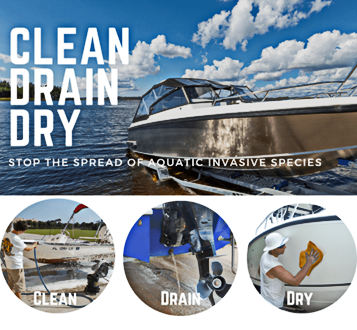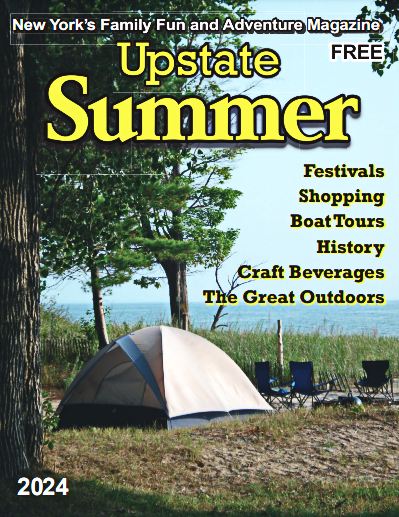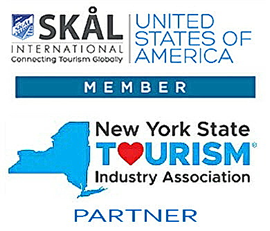- + LET'S GO THERE
- SKIING / WINTER ADVENTURE
- + THINGS TO DO
- + TOURS
- + WINE & DINE
- + STAY
- CALENDAR
- + MAPS, BLOGS & MORE
- Site Search
Follow These Actions to Prevent the Spread of Invasive Species
posted by Slelo Prism at 2023-06-21 08:05:00
Did you know that you can spread invasive species by boating, taking a hike, gardening, moving firewood, and many other activities you may enjoy? There are simple actions you can take to prevent the introduction and spread of invasive species while enjoying these activities.
 WHILE BOATING
WHILE BOATINGThe Issue: Aquatic invasive species (AIS) clog waterways, impede aquatic recreation, reduce waterfront property values and have many negative impacts on aquatic ecosystems and wildlife. AIS can easily hitchhike on watercraft, trailers, fishing equipment. You can unknowingly spread AIS to other waterbodies where they can easily spread.
Prevention Steps:
- Clean: Clean whatever comes into contact with the water, this includes your boat and trailer as well as, life jackets, fishing line and tackle, boat fenders, anchor, and anchor lines. As soon as you pull your boat out of the water, take a walk around the trailer and remove any plant debris you can see.
- Drain: Drain and empty live wells, bait buckets, and bilge water, and lower your boat motor as you are preparing your trailer before you leave the boat launch area.
- Dry: Dry your vessel, equipment, and fishing tackle for a minimum of 5 days before launching in a different body of water. Dry all parts of your boat. Zebra Mussel eggs can live out of the water for 5 days and an adult Zebra mussel can live out of water for 2 weeks. By ensuring proper dry time, you can significantly reduce the likelihood that aquatic invasive species will survive and be spread to other water bodies.
 WHILE HIKING
WHILE HIKINGThe Issue: The tread of your shoes can pick up plant seeds and even microscopic organisms, and pets can get plant seeds attached to their fur that can easily spread to areas you explore or travel back home with you.
Prevention Steps:
- Use a boot brush to clean the tread of your shoes before and after hiking. Many trails have installed boot brush stations at their trailheads for public use. Handheld boot brushes can also be purchased from the PlayCleanGo store.
- Check your pets for any seeds that may have attached to their fur and give them a bath after hiking. Be sure to check them and yourself for ticks as well!
 WHILE USING FIREWOOD
WHILE USING FIREWOODThe Issue: Invasive insects like the emerald ash borer, and long-horned beetle can easily hitchhike inside firewood. The larvae of these insect’s burrow tunnels in the wood, pupate and emerge as adults. Invasive tree pests cause tree mortality and can significantly impact the overall health of natural and urban forests.
Prevention Steps:
- Source Local Firewood: In New York State there are regulations against moving firewood more than 50 miles from where it originated. While camping, be sure to not bring unused firewood home or to bring firewood that was sourced more than 50 miles from where you will use it.
- Buy Certified Heat-treated Firewood: To be considered “treated firewood” in New York, a government certified facility must subject the firewood to a heat-treatment process that is hot enough – and for long enough – to kill any pests in the wood (in New York this standard is 71° C (160° F) for 75 minutes).
 WHILE GARDENING
WHILE GARDENINGThe Issue: Many invasive plants were once considered desirable ornamentals that were intentionally introduced to our gardens and landscapes only to escape into our natural environments. Once established, invasive species easily outcompete native species which reduces the availability of food and shelter for native wildlife and hinders the functionality of natural systems.
Prevention Steps:
- Choose Native Alternatives: You can play a vital role in the introduction and the prevention of invasive plants by choosing to grow native plants in your yard rather than exotic, non-native and invasive plants.
- Learn about native alternatives to common invasive plants in this Protector's Activity Blog.
About Invasive Species
Invasive species are non-native species that cause harm to the environment, economy, or human health. Invasive species are easily spread by people and can have huge consequences when introduced to natural ecosystems.
About SLELO PRISM
The St. Lawrence–Eastern Lake Ontario Partnership for Regional Invasive Species Management (SLELO PRISM) is one of eight PRISMs that span the state of New York. The PRISM network stemmed from recommendations from the NYS Invasive Species Task Force in 2005 and became fully established in 2014. PRISMs are funded by the NYS Environmental Protection fund in coordination with the NYS Department of Environmental Conservation and various partners. PRISMs have made tremendous progress towards preventing the introduction and spread of invasive species and mitigating the impacts of existing invasive species within the state.
 SLELO PRISM is hosted by The Nature Conservancy and was formally recognized by NYS in 2011. Their mission is to protect native habitats, biodiversity, natural areas, and freshwater resources, utilizing a collaborative and integrated approach to invasive species management with an emphasis on prevention, early detection, rapid response, education, and outreach. The work
SLELO PRISM is hosted by The Nature Conservancy and was formally recognized by NYS in 2011. Their mission is to protect native habitats, biodiversity, natural areas, and freshwater resources, utilizing a collaborative and integrated approach to invasive species management with an emphasis on prevention, early detection, rapid response, education, and outreach. The workposted at: 2023-06-21 08:05:00, last updated: 2023-06-21 10:47:28

















